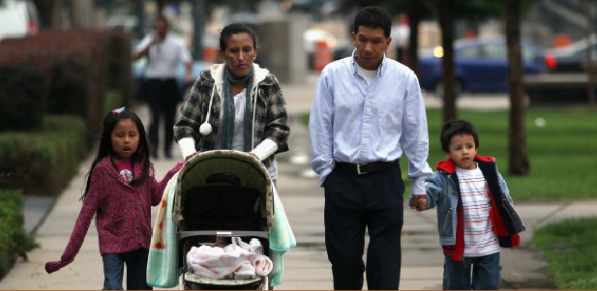Hispanics
and Caribbeans
Americans
of Hispanic origin are the fastest growing minority today representing more
than 12.5% of the American population.
Hispanics
form a diverse community because of their origins: a majority comes from Mexico
(Mexican Americans or Chicanos). The two other leading groups are Puerto Ricans
and Cubans.
Hispanics
as a whole come from 20 different countries. Therefore, there is little unity
racially speaking. They form a heterogeneous socio-economic profile:
·
Anti-communist Cubans of the
first wave were the most successful Hispanics as most of them were skilled
professionals and managers in their homeland.
·
Puerto Ricans have been
disadvantaged as far as education is concerned and can be said to be in a worse
situation than African Americans
·
Mexican Americans stand in
between.
In
spite of their diversity, Hispanics are united on several fronts:
·
Linguistically: Spanish is the
most widely spoken foreign language in the US
·
Religiously the majority are
overwhelmingly Roman Catholic
·
Geographically: most live in
the Sunbelt States (50% in California and Florida)
·
Socially: They have more
stable family structures (70% of household are headed by a married couple) and
a higher birth rate (18% more than 3 children)
·
Professionally: A large
proportion of the Hispanic community belongs to the working class with jobs in
agriculture, textile and garment industries, catering and domestic work.
Because of illegal immigration, many work in the Underground economy.
Pattern
of integration: Many Hispanics do not wish to apply for American citizenship,
some never learn English. (Today the US is the 5th Spanish speaking
country in the world). Many Hispanics retain an exile mentality. Cubans for
instance who fled Fidel Castro in the 60’s never expected to remain in the US.
Many
Mexican-Americans do not regard themselves as immigrants but feel they are
settling on a territory that formerly was theirs. As they also hold on to their
language and traditions, it has been said that they are building a “nation
within the nation.”
Asian
Americans (4% of US population)
Before
the Chinese exclusion act of 1882, many Chinese came to the west coast of the
US to build the railroads work in gold mines or as domestic servants.
The
community is made up of Chinese, Filipinos, Japanese, Koreans and Vietnamese Refugees also came from Laos,
Cambodia, Thailand and India.
This
is a diverse community but which does share similarities. Asians are mainly
known for their excellent academic achievements and spectacular assimilation.
They integrate well, learn English quickly and ask for American citizenship.
They often outperform whites at school and university especially in science:
30% of Berkley students, 20% of MIT and 15% of Harvad and Stanford.
The
reasons for this success story are cultural. They have a Confucian view of the
world (Confucius) which places a high premium on education, discipline and
strong family ties. Asians therefore fully embrace the American work ethic and
competitive spirit.
This
success and their label as being a “model minority” generated animosity among
whites as well as other minority groups. In the Los Angeles riots of 1992,
blacks targeted Asian-owned stores.
Furthermore, they are affected by forms of disguised discrimination: some universities where accused of imposing
quotas to curb Asian presence.
.
American
Indians/Native Americans
There
are 2 million American Indians and about 500 different tribes: Cherokees,
Navajos, Sioux, Chippewa’s, Choctaw, Pueblos, Apaches , Iroquois, Lumbees,
Creeks.
| Indian Reservation in Wisconsin, During their annual Pow Wow |
Most
of them live in the Southwest (Arizona, New Mexico, Oklahoma, Utah and Nevada)
often on one of the 100 reservations.
Native
Americans have experienced a history of painful struggle that began in the
colonial period and continues today.
The
only native Americans were
slaughtered in the 18th and 19th century by frontiersmen who
disregarded treaties signed between Washington and various tribes.
Those
that did not die in the battles were moved to reservations.
The
government had confusing policies with American Indians:
| Mass Grave after the Wounded Knee Massacre |
·
Elimination by military means (the
battles of Big Horn 1876 and Wounded Knee, 1890);
·
Assimilation as with the Indian reorganization Act in 1934.
All Indians were granted citizenship in 1924
The
status of American Indians is very often precarious. It is a predominantly rural
population living below the poverty line outside the mainstream of American
society.
40%
of the Indians on the Navajo reservation in Arizona are out of work for
instance.
Many
of them work low-skill, low-wage branches. Others live off their local crafts.
Indians,
especially those living in poorer reservations are suffering from many social
ills: inadequate housing, disease, poor schooling and health and a high rate of
alcoholism and suicide especially among the young.
Today,
American Indians are torn between the need to adapt to modern American society
and to keep their identity and tribal customs alive.
These
are the goals of the National Congress of American Indians (1944) and the
National Indian Youth Council (1961) both of which refuse assimilation.

If you had financial problems, then it is time for you to smile. You only need to contact Mr. Benjamin with the amount you wish to borrow and the payment period that suits you and you will have your loan within three working days. I just benefited for the sixth time a loan of 700 thousand dollars for a period of 180 months with the possibility of paying before the expiration date. Mr Benjamin has be helping me with loan.Make contact with him and you will see that he is a very honest man with a good heart.His email is lfdsloans@lemeridianfds.com and his WhatApp phone number is + 1-989-394-3740
RépondreSupprimer